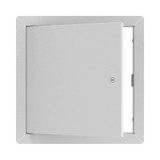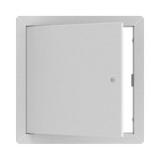How Insulated Access Doors Contribute to Net-Zero Goals in Canada’s Construction Industry
Canada is experiencing a rise in sustainable building practices due to climate change concerns and growing environmental awareness. The government promotes net-zero construction by updating building codes for stricter energy efficiency and offering financial incentives for builders.
Net-zero buildings produce as much energy as they consume annually, using high-performance insulation, efficient windows, advanced controls, and renewable energy sources like solar panels. The building envelope, which includes walls, roofs, and high-performance windows, plays a crucial role in energy efficiency.
Insulated access doors enhance thermal management, which is crucial for keeping energy efficiency in these buildings. High-quality insulated access doors are essential for achieving net-zero goals and reducing energy consumption.
How Insulated Access Doors Contribute to Net-Zero Goals
Energy Efficiency
Traditional access doors can compromise a building's insulation, leading to heat loss in winter and gain in summer, which increases energy consumption.
In contrast, well-insulated doors provide effective thermal performance with high R-values, reducing heating and cooling demands and saving energy.
Improved Indoor Air Quality
Airtight seals on insulated access doors prevent air infiltration, which can lead to increased energy usage as heating and cooling systems work harder to maintain comfortable indoor temperature.
Additionally, outside air can bring pollutants into the building, compromising indoor air quality. Minimizing air infiltration enhances air quality while reducing energy consumption.
Building Envelope Integrity
Insulated access doors are designed to lessen thermal bridging, which occurs when heat flows through conductive materials, compromising energy efficiency. These doors are made from durable materials that withstand harsh weather and enhance long-term energy efficiency.
Integration With Other Building Systems
Access doors must integrate with other high-performance building envelope components, such as advanced insulation and air-barrier systems, for optimum energy efficiency.
Selecting the Right Insulated Access Doors for Net-Zero Projects
Choosing insulated access doors and panels is vital for maximizing energy efficiency in net-zero construction. Key considerations include:
Thermal Performance
Focus on the R-value and U-value. Higher R-values indicate better insulation, while lower U-values signify improved efficiency. To maintain indoor temperatures, address air leakage around frames with quality seals and weatherstripping.
Durability and Longevity
Prioritize materials like steel or aluminum for durability against corrosion and impact. Choose ones that have sturdy construction to withstand harsh weather conditions.
Ease of Installation
Select doors that are easy to install to reduce labor costs and avoid delays. Clear installation instructions help minimize errors.
Aesthetics
Choose access doors that complement the building's architectural style for enhanced visual appeal.
Available Options
Standard insulated access doors offer basic insulation, while high-performance and super-insulated doors, like the ADC-XTA Super-Insulated Exterior Panels, enhance energy efficiency for demanding environments.
Custom-built options are available for unique project needs.
Working With Manufacturers and Suppliers
Collaborating with experienced manufacturers and suppliers is essential. At Access Doors Canada, we offer our expertise on the latest technologies to help you choose the right products based on your budget, energy goals, and code compliance.
Actionable Insights for Architects, Designers, Builders, and Contractors
Achieving net-zero construction goals requires collaboration among all stakeholders. Here are concise insights for professionals:
Incorporate Insulated Access Doors Early
Integrating insulated access doors in the design phase minimizes heat loss and enhances energy efficiency. It ensures best placement and alignment with architectural designs, preventing costly delays.
Conduct Thorough Research and Select Products Wisely
Rank thermal performance with high R-values and low U-values for energy efficiency. Choose durable materials and ensure doors meet fire safety codes for compliance and safety.
Focus on Quality Over Cost
Investing in high-quality access solutions leads to lower long-term energy and operational costs. Energy-efficient buildings are also more desirable, increasing their property value.
Ensure Proper Installation
Follow manufacturer instructions for best energy performance. Use qualified installers and conduct regular inspections to find and address leaks or damage.
Stay Informed About Best Practices
Commit to continuous learning by keeping updated on advancements in insulated access doors and sustainable practices through industry publications and professional development courses. For the latest insights on insulated access doors and sustainable building practices, visit our blog.
By following these insights, stakeholders can promote the adoption of insulated access doors and support net-zero construction in Canada.
Conclusion
Net-zero construction is crucial for reducing environmental impact and achieving sustainability. While energy-efficient windows and high-performance insulation are often emphasized, components like insulated access doors should not be overlooked.
Using net-zero insulated access doors in Canada is crucial for net-zero construction. Investing in these energy-efficient solutions decreases energy consumption and greenhouse gas emissions, leading to lower energy bills and long-term financial benefits.
Architects, designers, builders, and contractors must focus on energy efficiency and adopt high-quality insulated access doors to promote sustainable building practices and contribute to a more sustainable future for all Canadians.









